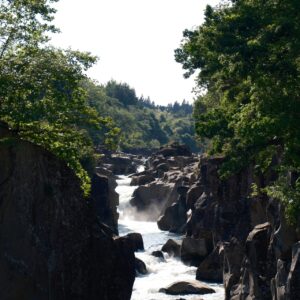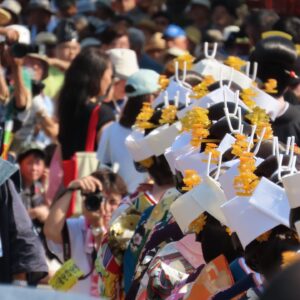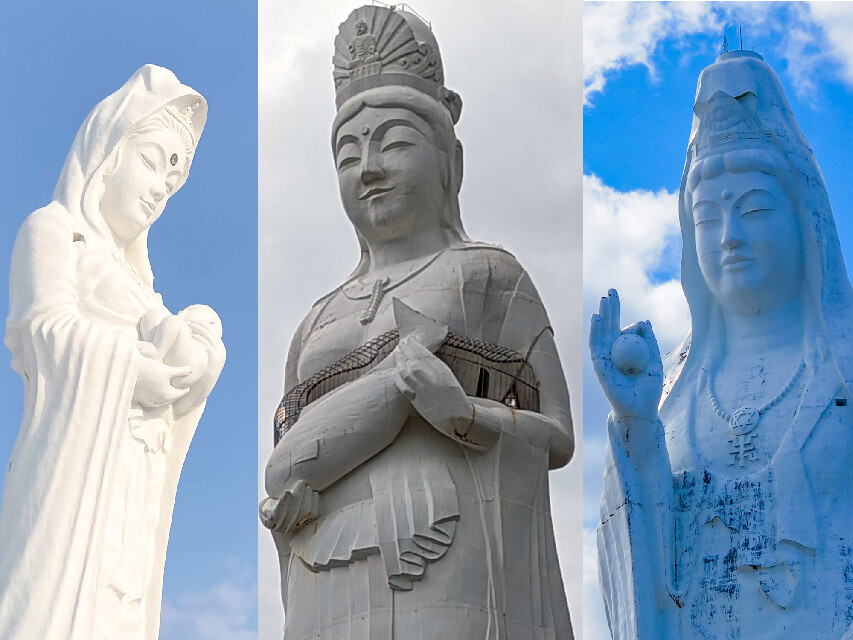
[Kamaishi City, Iwate Prefecture] “Kamaishi Daikannon” is a giant Buddha that watches over Kamaishi Bay, one of the three great giant Buddhas in Tohoku
table of contents
``Giant Buddha'' have been built in Japan Although there are no clear standards for buildings considered to be "giant Buddhas," Yasuo Tsugawa, a researcher in urban geography, commercial geography, and landmark research, and professor emeritus at Takasaki University of Economics, has written a book. In ``Religious Landmarks and Their Requirements - Using the Great Kannon Statue as an Example'', the standard for giant Buddhas is 25 meters or more, and the novelist Tamaki Miyata also states in his book ``On a sunny day, ``There is no exact reason, but a general rule of thumb is that it is bigger than Ultraman,'' he wrote in ``Seeing the Buddha,'' and considers anything over 40 meters tall to be a ``giant Buddha.''
In any case, there are no clear criteria for a giant Buddha or a huge building that is an object of worship as a "giant Buddha." That's a good place according to each individual's standards.
However, it is certain that its gigantic appearance has become a symbol of the city, regardless of faith or religion.
This time, I would like to take a closer look at the "Kamaishi Daikannon," which faces Kamaishi Bay and watches over Kamaishi City and the world, along with two other "giant Buddhas" that exist in Tohoku.
Three "giant Buddhas" in Tohoku
I live in Miyagi Prefecture, so when I hear the word "Giant Buddha," the first thing that the Sendai Daikannon , but I also know that there are three "Giant Buddhas" in Tohoku. Do you know?
Daikanmitsu-ji Temple, "Sendai Daikannon (Sendai Tendo White-robed Daikannon)"

"Sendai Daikannon" located in Sendai City, Miyagi Prefecture, was completed in 1991, has a "standing statue" posture, a height of 100m, and the type of statue is " white-robed Kannon" The official name of this "Sendai Daikannon" is "Sendai Tendo Hakui Daikannon" it is located in the precincts of "Daikanmitsuji" It is affectionately known by the locals ``Nakayama Kannon.''
It is also possible to see the inside of the Sendai Kannon, which is divided into 12 layers and has a 60m long atrium. On the 12th floor, observation windows are installed on the ventral and dorsal sides of the Daikannon, and you can see the city center side and Izumigatake side respectively. If the weather is good, you can even see the Oshika Peninsula, which is about 60km away.
There is also an elevator inside the womb, allowing you to go directly up to the 12th floor.
It was built out of the deep faith of the local people.
The Sendai Daikannon was built in 1964 by the Futaba Group, a local Sendai company, when it developed a large-scale residential area and leisure facilities named Nakayama. It is said that the founder, Mr. Man Sugawara, requested the construction of a large statue of Kannon out of his faith and desire to create a famous place in Sendai, believing that the success of his business was due to the Kannon he worshiped on a daily basis.
Information
- Name: Sendai Tendo White-robed Kannon
- Address: 31-36 Misawa Nakayama Minami, Izumi Ward, Sendai City, Miyagi Prefecture 981-3217
- Opening: September 1, 1991
- Sect: Shingon sect Chizan sect
- Opening hours
- Weekdays: 10am to 3pm
- Saturdays, Sundays, and holidays: 10:00 a.m. to 3:30 p.m.
- Admission fee: 500 yen
Google Map
Hokokuji Temple Aizu Betsuin, “Aizu Jibo Daikannon”

The Aizu Jibo Daikannon located in Aizuwakamatsu City, Fukushima Prefecture, was completed in 1987.It has the posture of a standing statue, is 57m tall, and is characterized by its round shape, which gently holds a baby in both hands. The Daikannon is a giant Buddha and land that was originally owned by Tsurukame Construction Co., Ltd., but the land, building, and management rights have now been transferred to the religious corporation Hokokuji/Aizu Betsuin.
It is also possible to tour the inside of Aizu Jibo Daikannon. Inside are enshrined 10,000 Buddha statues, 1/25th statues that shine in gold, and the main image of the 12 animals of the zodiac, and from the observation windows scattered here and there at 40 meters from chest height, you can see the sights of Aizu. You can see the townscape, the countryside of the basin, Mt. Bandai, the Iide Mountain Range, and more.
Aizu Village where the Aizu Jibo Daikannon is located, is a tourist destination with a vast Japanese garden of 60,000 tsubo (60,000 tsubo). Various plants are planted.
Built from a prayer for peace
The 57-meter-tall Aizu Jibo Daikannon was built in 1986 to pray for world peace, and the late Shonosuke Haga of Tsurukame Construction Co., Ltd. founded Aizu Village to pray for world peace.The total construction cost was 10. The Aizu Jibo Daikannon was built at a cost of 100 million yen. In addition to the Aizu Mother Kannon, there is also a 13.4-meter-long statue of Shakyamuni Buddha reclining on the premises of Aizu Village which was displayed in the Sri Lanka Pavilion at the 1985 Tsukuba Expo. It is said to be the "Nirvana Buddha"
Information
- Name: Aizu Jibo Daikannon
- Address: 178 Nagahara Higashi Koya, Kawato-cho, Aizuwakamatsu-shi, Fukushima 969-3461 (on the grounds of Aizu Village)
- Opening: 1986
- Sect: Jodo Sect Succeeding Sect
- Opening hours
- April to November: 9 a.m. to 5 p.m.
- December - March: 10am - 4pm
- Admission fee: 500 yen for adults, 400 yen for junior high and high school students, 300 yen for elementary school students
Google Map
Meihouzan Sekiozenji Temple, “Kamaishi Daikannon”

"Kamaishi Daikannon" located in Kamaishi City, Iwate Prefecture , was completed in 1970, has a "standing statue" posture, a "fish basket Kannon" , and is 48.5 meters tall. This is the oldest "Giant Buddha" among the "Giant Buddhas" in Tohoku. It was erected Sekio-ji Temple , and the inside of the temple is a spiral staircase that runs from the right forearm, through the fish section, and over the left elbow, forming an observation deck.
Kamaishi Daikannon is built on a small hill on the Kamasaki Peninsula in Ohira Town, and there is an escalator halfway up the hill, so you can easily view it.
``Kamaishi Daikannon'', which prays for peace in the ghost and light worlds
The ``Kamaishi Daikannon,'' a chalk statue of Kannon with a fish basket, which stands on the Kamazaki Peninsula in Ohira Town, was erected in April 1970 at the request of the 17th head priest of Sekiozenji Temple, Untei Seiro. Ta. The main purpose of this festival is to enlighten the souls of those who have passed away due to various reasons through the compassion of the Bodhisattva Avalokitesvara and guide them to Bodhi, as well as to relieve people living in this world from suffering, and pray for peace in both the worlds of light and light.
Information
- Name: Kamaishi Daikannon
- Address: 3-9-1 Ohira-cho, Kamaishi, Iwate 026-0002
- Opening: April 8, 1970
- Sect: Soto sect
- Opening hours
- 9:00 a.m. to 4:30 p.m. (last entry) 5:00 p.m. (gates close) *Subject to change depending on the season
- Admission fee
- Individuals: Adults 500 yen, junior high and high school students 300 yen, elementary school students 100 yen
- Groups (20 people or more): Adults 450 yen, Junior and senior high school students 270 yen, Elementary school students 100 yen
- Groups (more than 100 people): Adults 400 yen, Junior high and high school students 240 yen, Elementary school students 100 yen
Google Map
My actual visit to the Kamaishi Daikannon at Meihouzan Sekiozenji Temple
I introduced three "giant Buddhas" above, but this time I visited the "Kamaishi Daikannon" in Kamaishi City, Iwate Prefecture. Personally, I don't have any strong religious beliefs, and I'm sorry to say that I just want to see my parents' grave, so the reason I visited was simply for sightseeing.
However, I've heard for some time that there is a huge Kannon statue in Kamaishi, so I'm going to write an exciting and nervous report, but I hope you will read the text for a little while longer.
Welcome, Kamaishi Daikannon

Kamaishi Daikannon is located in Ohira-cho, Kamaishi City, Iwate Prefecture, on the Kamazaki Peninsula in Ohira-cho, just a stone's throw from Iwate Prefectural Kamaishi Shoko High School. The site is large, and in addition to the Kamaishi Daikannon, there are Sanmon Gate, Fudoden Hall, and a Stupa, and the free parking lot is large enough to accommodate 15 large buses and 150 passenger cars.

The thing that surprised me the most when I visited without any prior information was that there was a Nakamise street in front of the main gate of Kamaishi Daikannon.
Kamaishi Daikannon Nakamise Street

As you can see in the photo above, it is now very rundown and most of the shops are closed, but it seems like it was once full of bustle and energy, similar to the Nakamise shopping district in Asakusa, Tokyo. Don't get me wrong, not all shops are closed, and Kamaishi Daikannon Nakamise Street has not disappeared.
Even now, there are several local businesses that are renovating and reopening old stores. All of our stores have stylish exteriors that give you a good impression. The website has also been carefully designed, so if you have time, please take a look at the link below.
Kamaishi Daikannon Nakamise Street Official Homepage
Pass Kamaishi Daikannon Nakamise Street and head to the Sanmon Gate

From this Sanmon gate, you will ascend to Sekiozenji Temple and Kamaishi Daikannon. On either side of the Sanmon gate are enshrined two Nio statues, A and Un, made by Kyoto Buddhist sculptors, Hakuun Sakuma and Keiun Sakuma, who were established in July 1976.
Pass through the Sanmon gate, go to the ticket office, pay the admission fee, and head to Kamaishi Daikannon! When I headed there, I saw the entrance in front of me, was it an indoor staircase meant to protect me from the rain and wind? I was shocked when I thought about this, and when I went inside...
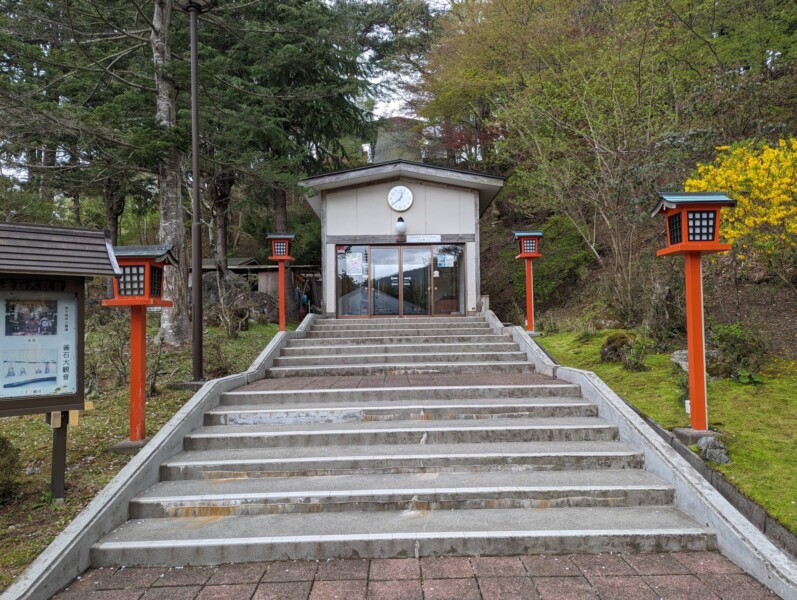
You can see an escalator right in front of you.

I'm overflowing with love. You can go there on foot, but of course I use the escalator. I think of this as a kind of attraction.

When you climb the 37m long escalator, the back of Kamaishi Daikannon will appear in front of you.
Kamaishi Daikannon

Kamaishi Daikannon is located 120m above sea level, and Kamaishi Bay stretches out in front of you. In the distance, you can see the magnificent ria coastline of Rikuchu Kaigan National Park, as far as Cape Mada and the Ozaki Peninsula.

In 2016, Kamaishi Daikannon was selected as a ``Lover's Sanctuary'' a "wishing bell" designed by a woman from Kamaishi , and many people come to take pictures in front of the monument and ring the bell to wish for love fulfillment, making it a power spot for finding new love fulfillment. is visiting.

Although I am visiting on my own, I have been touched by the love of Kamaishi Daikannon and have thoroughly enjoyed Kamaishi Bay, so I am now going to dive into the womb of Kamaishi Daikannon.
Kamaishi Daikannon, one of the 33 Kannons, is a fish basket Kannon.

Kamaishi Daikannon has the appearance of a "fish basket Kannon" What is Kannon?
A beautiful girl carrying a fish basket visits a village in Henan Province, a place of no religion, to sell fish.
Kamaishi Daikannon Origin of Uoran Kannon
Young people in the area competed to marry her, but the troubled girl promised that the man who could recite the Kannon Sutra, the Diamond Sutra, and the Lotus Sutra would be her husband. Her daughter was married to a young man who had masterfully recited three sutras, but soon the daughter fell ill and she became a guest of no return. A few days after her funeral, she dug a grave for her under the instructions of an old monk in purple robes, only to find that her daughter's corpse was not there, only her golden collarbone. This girl is said to be the incarnation of Kannon Daishi, who appeared to spread the Lotus Sutra, and from then on she came to be worshiped as Uoran Kannon.
It has been with.

Once inside the womb, there is no elevator, so you will have to take the stairs to view it. The restrooms are only available on the 1st floor for men and on the 2nd floor for women, so we recommend that you go there first.
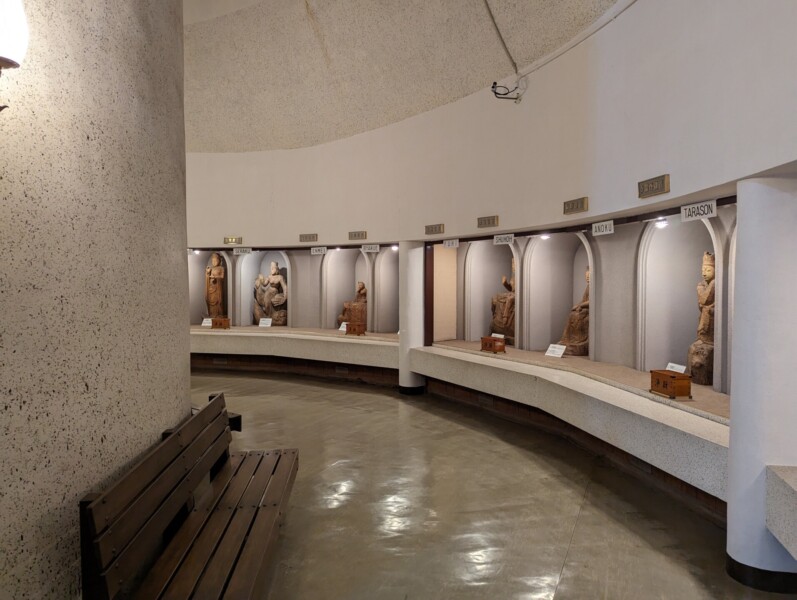
Inside the womb, the 33 Kannon statues are displayed in a machete-carved style made from 33 camphor trees, in which Kannon transformed into various forms in order to save sentient beings.

Wooden carvings of the Seven Lucky Gods are enshrined on each floor from the 2nd floor to the 11th floor. . yeah? 11th floor...? that's right. You can only climb the stairs to the 11th floor of Kamaishi Daikannon and then to the 12th floor, which is the observation area.

The width of the stairs varies and there are some narrow spots. The stairs going down are the same, so please be careful when passing other visitors.

Climb up to the 12th floor and the Uoran Observation Deck , where you can enjoy a panoramic view of Kamaishi Bay from above the fish held by the Uoran Kannon in both hands. However, the observation space is not very large, and since I am barricaded with iron fences, I was afraid of heights and could barely take a photo. I think people who like heights and spectacular views will be very satisfied.
This will be your final destination, and you will then have to descend the stairs you climbed.

There is also a shop at the base of Kamaishi Daikannon, so we recommend purchasing souvenirs after visiting.
summary
This concludes this report on Kamaishi Daikannon.
All Kannon statues (giant Buddhas) are objects of religion and belief, and are not something to be taken lightly, but if you look into them as ``giant Buddhas,'' they will refuse visitors because they are not sectarian. It does not mean that.
It might be a good idea to visit as part of your sightseeing trip or as a theme park-like place.



![[Iwate Prefecture] That person might have gone too! ? 5 recommended power spots in Iwate Prefecture 26634518_m](https://jp.neft.asia/wp-content/uploads/2023/06/26634518_m-150x150.jpg)
![What is the Kamaishi Railway, the first and third in Japan in the Tohoku region? [Kamaishi City, Iwate Prefecture] Government Kamaishi Railway serial number 2793](https://jp.neft.asia/wp-content/uploads/2024/03/KamaishiRailway-No1SL-150x150.jpg)
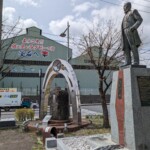
![Sanriku International Art Festival 2024 | An event will be held again this year where local performing arts from the Sanriku region will be gathered together [Aomori/Iwate] Sanriku International Art Festival 2024](https://jp.neft.asia/wp-content/uploads/2024/08/main-150x150.png)
![Sanriku performing arts come together! Photo report from the Sanriku International Arts Festival 2025 "Kamasu" [Kamaishi City, Iwate Prefecture] Nishikimachi Toramai (Kamaishi City)](https://jp.neft.asia/wp-content/uploads/2025/10/DSC_01162-150x150.jpg)
![A tour of local ramen in the six Tohoku prefectures! Kamaishi Ramen, which supported steel production [Kamaishi City, Iwate Prefecture] Kamaishi Ramen Catch](https://jp.neft.asia/wp-content/uploads/2025/11/bd63bca9fdfcc6f64fb57ba24521e1e9-150x150.jpg)


